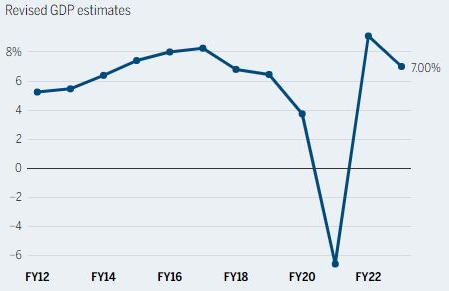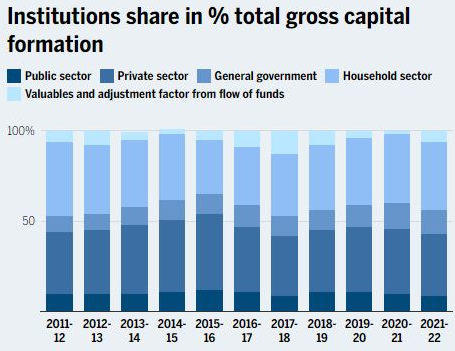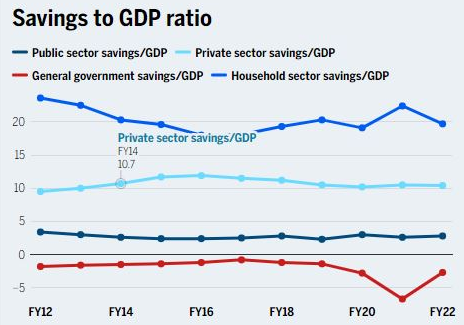11 Mar Hindu Rate of Growth
Hindu Rate of Growth
This article covers “Daily current affairs for UPSC “and the topic is ‘The Hindu Rate of Growth’ which is in the news, it covers “Economics” In GS-3, and the following content has relevance for UPSC.
For Prelims: Hindu Rate of Growth
For Mains: GS-3, Economics
Why in news: The State Bank of India published a report titled “Ecowrap” on March 7, 2023, demonstrating that the idea of the “Hindu” rate of growth has no basis in the current situation.
- Raghuram Rajan, a former governor of the Reserve Bank of India, recently stated that the Indian economy is “dangerously close” to growing at the “Hindu” rate.
- He attributed the slowdown in the global economy too weak private sector investment, high-interest rates, and these factors.
About the Hindu Rate of Growth
- Raj Krishna, a late economist, first used the term in 1978.
- It describes the nation’s slow growth, which essentially refers to the slow rate of economic expansion from the 1950s through the 1980s.
- An average of 3.5% was the Indian economy during this time.
- Hindu rates of growth can only be identified if they are consistently low and accompanied by low per-capita GDP, and they must also take population growth into account.
- A Hindu rate is often used In a negative sense: According to A Dictionary of Politics and International Relations in India, the term “Hindu Rate of Development” is frequently used as an insult to refer to India’s inability to realize its full economic potential.
When did India’s growth rate surpass that of the Hindu rate of growth?
- According to GDP growth rate data, India began to expand more rapidly than the Hindu pace of 3.5% a long time before the crisis and reforms of 1991.
- Between 1956 and 1975, India’s average annual GDP growth rate was 3.4%, which is nearly identical to the Hindu rate of growth.
- Yet, India’s growth averaged 5.8% between 1981 and 1991, a full decade before the crisis and reforms.
How has India’s GDP been increasing?
- Due to the pandemic, it decreased in the first quarter of the fiscal year 2020–2021 by an astounding 23.8%.
- India’s GDP started increasing as the lockdowns started to loosen and commercial operations resumed.
- The conflict that affected nearly all of the world’s main economies in FY22–23 created new economic difficulties, slowed growth, and increased inflation to record levels.

India’s GDP increasing rate
What did the SBI report say about investments and savings?
- Claims are “ill-conceived, biased, and premature” in light of the most recent GDP figures and the information on savings and investments that is currently available. India is thought to be perilously close to the Hindu rate of growth.
- According to the SBI report “Ecowrap,” interpreting GDP growth based on noisy quarterly data is a game of smoke and mirror.
- First impressions suggest that the Incremental Capital Output ratio (ICOR), Significantly reducing ICOR in recent years indicates that the economy is stable and implies a comparatively rising level of capital efficiency.
- ICOR calculates the incremental capital investment needed to generate increased output units.
- Quarterly growth numbers should be avoided for any serious interpretation because they are noisy.
- Future GDP growth rates, even if they are only 7%, might still be considered good by any standard.

SBI report on investment and saving
- Gross capital formation (GCF): The government’s GCF increased from 10.7% in 2020–21 to a high of 11.8% in 2021–2022.
- Private sector investment: The private sector’s investment also increased as a result, from 10% to 10.8% over the same time period.
- Gross savings: Gross savings increased from 29% in 2020–2021 to 30% in 2021–2022.

Savings to GDP Ration
Conclusion
- The nation is advancing quickly across the board and is eager to compete with the finest in practically every industry.
- India has learned to care for its own in a world where each nation looks out for its own.
- India is currently far from reaching the 3.5% level that is thought to correspond to the Hindu rate of growth.
- It is interesting to note that India had been slowing down for the three years prior to the epidemic and had only seen 3.9% growth the year before Covid.
Source:
Daily Current Affairs for UPSC
Daily Current affairs are very crucial for preparing UPSC examination. If aspirants would like to pass the UPSC examination and want to become an IAS officer, they should read the latest daily current affairs regularly. Here, Plutus IAS provides the best daily current affairs for the UPSC examination free of cost. Also, get the weekly and monthly current affairs for the IAS exam preparation.




No Comments